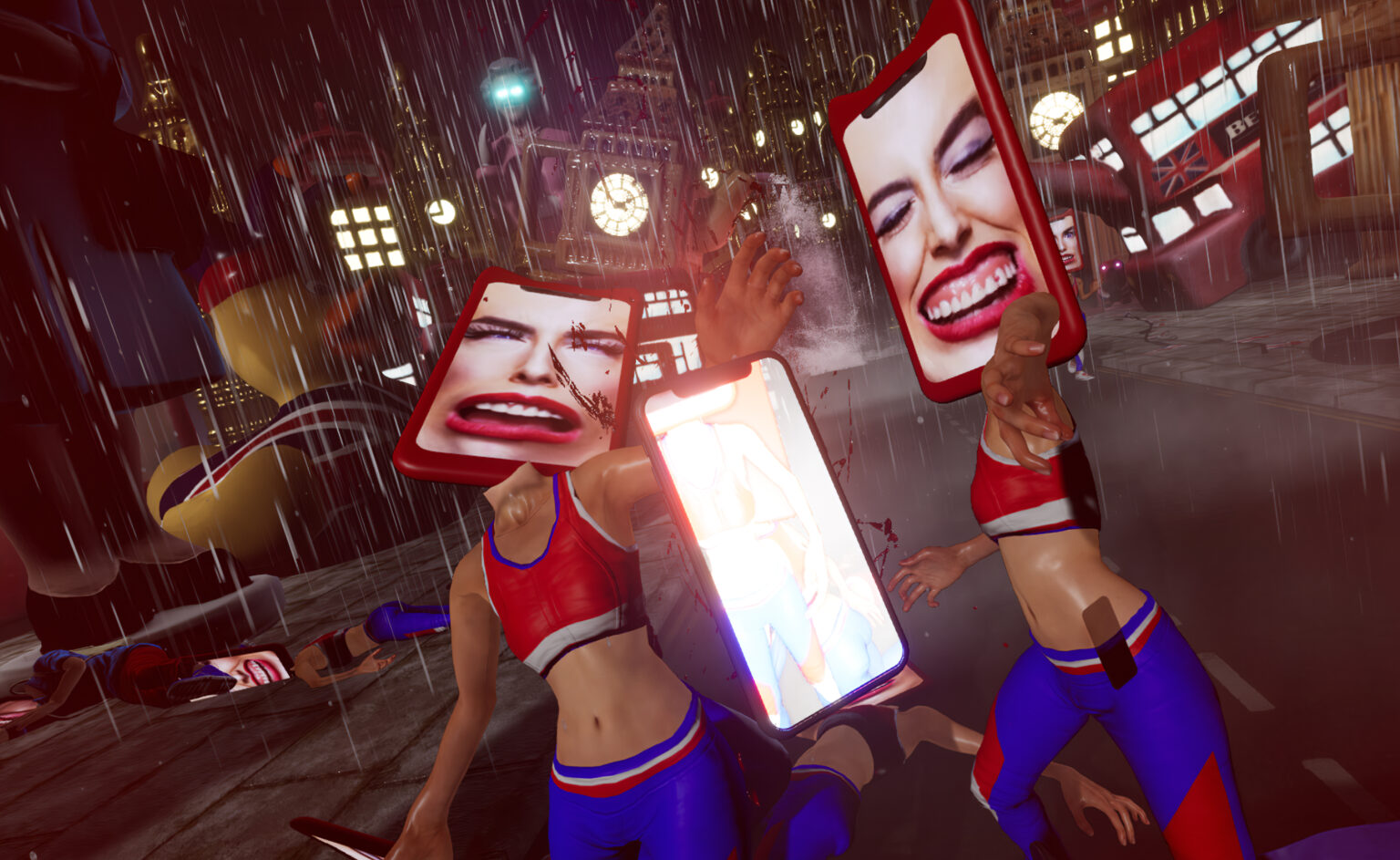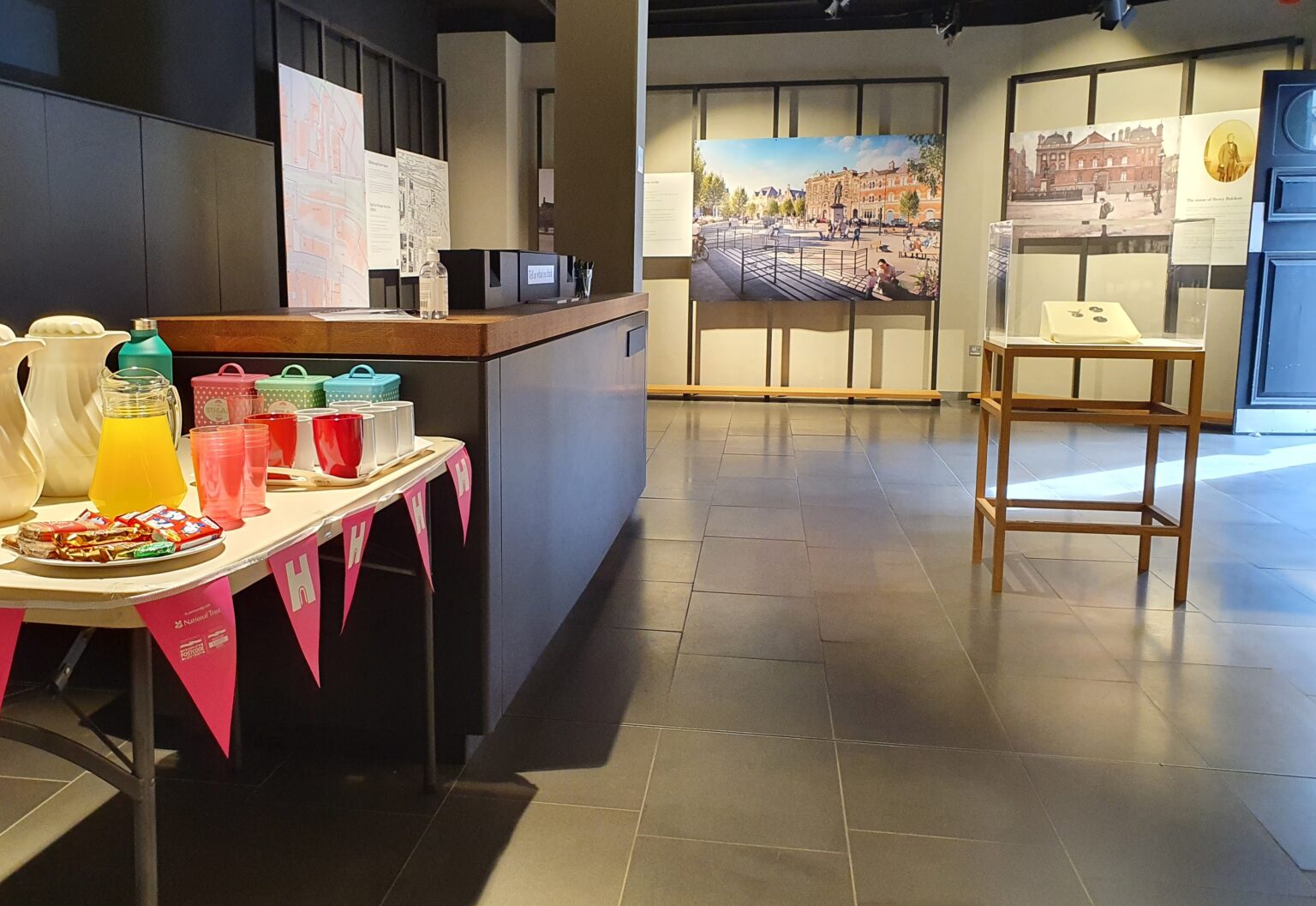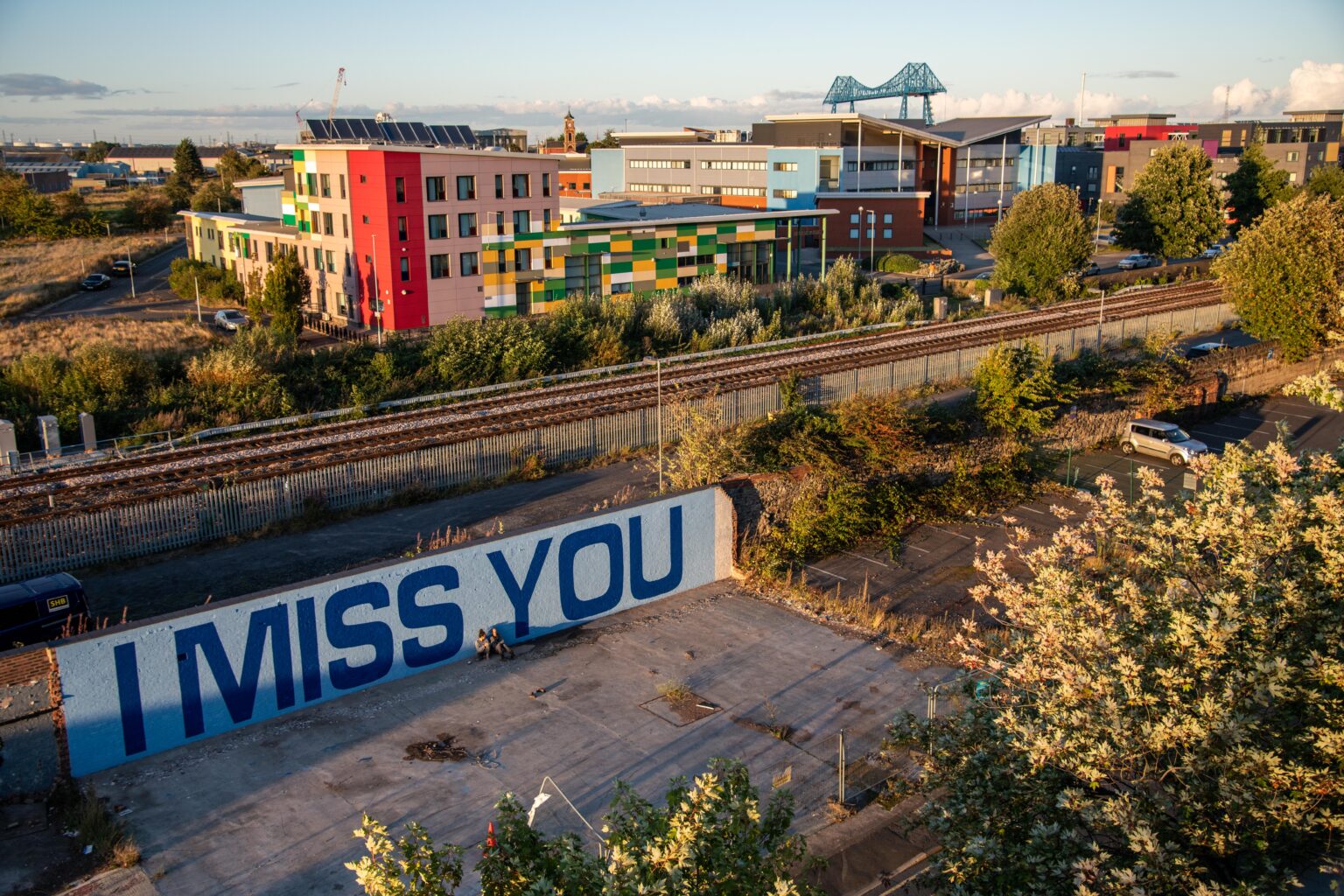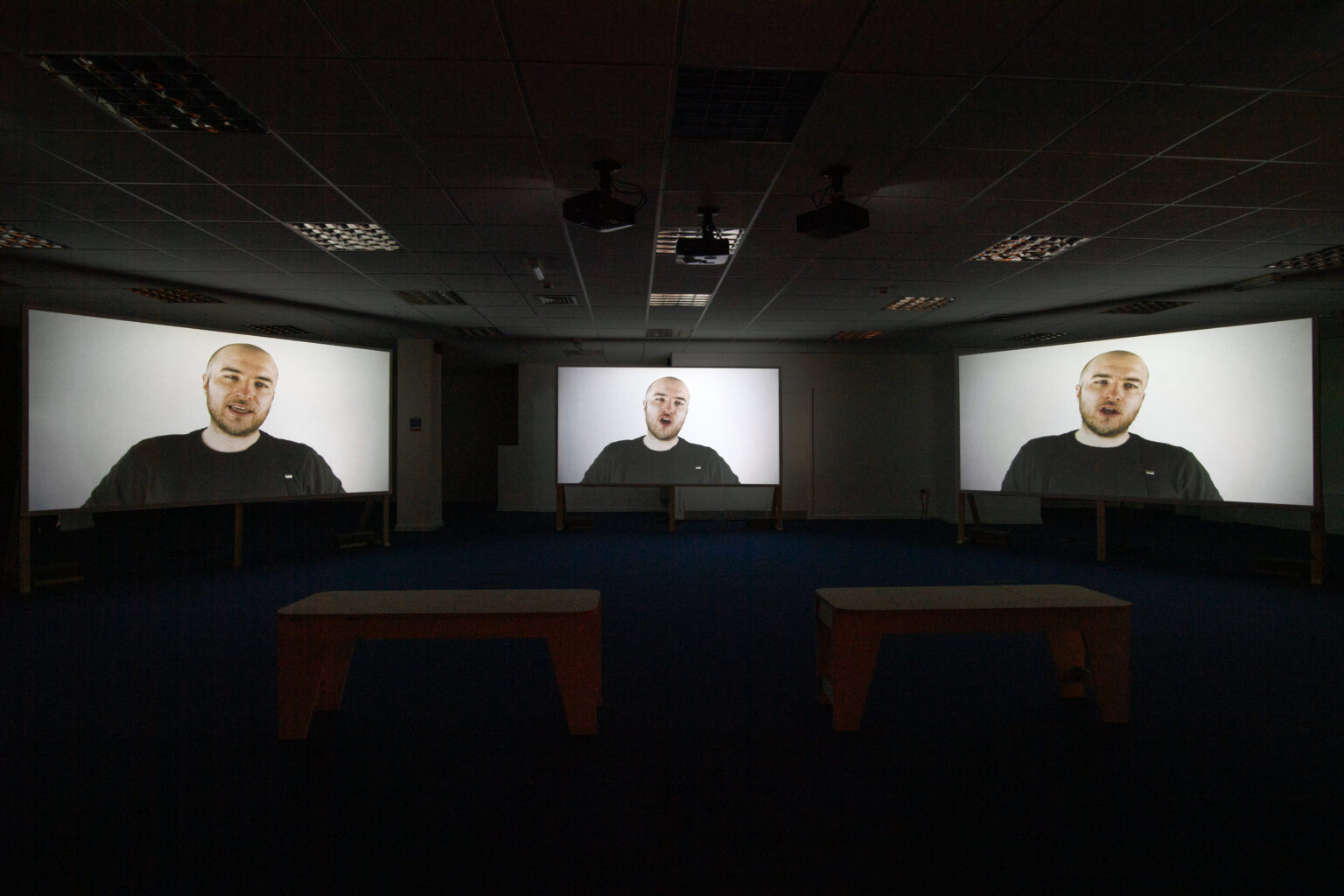I’m hounded by zombies with mobile phones for heads watched over by a monumental Queen Elizabeth with glowing eyes. Armed with a mobile phone that fires bullets, my panicked errant shooting lets me down and within seconds they’re all over me. I’m done for and I instinctively throw the VR headset off in a huff. I’ve seen a lot of VR work recently, yet nothing quite as visceral and discomforting as Rachel Maclean’s ‘I’m Terribly Sorry’ (2021). The installation is the centrepiece of a group exhibition at Pineapple Black, an artist-led space in the centre of Middlesbrough.
The show is the last stop on my day-long jaunt around Middlesbrough Art Weekender (MAW). With tired legs and frazzled nerves, I think back to the calmness at the start of the day, sat in a discussion at MIMA hosted by Women of the North-East Library (WANEL). Artist Fiona Larkin shared research from her residency exploring MIMA’s collection and WANEL’s archive, out of which she produced the publication Soft Power Soft Fictions, convening the voices of long-deceased and still living artists and writers including Moyra Davey, Kate Briggs and Ethel Guymer, among others, to explore gaps and erasures in historic collections. The book sediments influences that echo through her diaristic work – a lesson in networked and polyphonous storytelling. Larkin’s work reminded me of what it feels like to write on art: weaving impressions into narrative and analysis, speaking with and through others.
From flesh eating zombies to artistic ghosts, Larkin and Maclean’s sensibilities couldn’t be more opposite, and they provide a sense of the broad spectrum of artists involved in this year’s Weekender. Despite the recent pandemic, MAW – established in 2017 – has grown to become the largest visual arts festival in the North East and is now firmly established in the autumn calendar. This year’s iteration brings together over seventy-five artists under an overarching theme of ‘power POWER’ (double power: the first lowercase and the second uppercase) alongside a myriad of satellite events and exhibitions. The tautological title hints at the myriad ways that power exerts itself and the central show, spread over multiple venues, encompasses a broad array of works that examine the theme of power in its many guises.
Artists range from the ultra-famous to early career, their work exploring macro and micro power dynamics. Through painting to VR, sculpture and performance, they take on subjects as varied as geopolitical relations, extractive materialism and political divisionism. There is a general sense of iconoclasm, with artists debunking, satirising, deconstructing, ridiculing and making mischief to reveal the often hidden power relations that shape the world. It’s all very ambitious and it can sometimes feel slightly disparate.

In the moving image work ‘Ada vs Abramović’ (2018) at The Auxillary, artist Hannah Cooke participates in a re-staging of Marina Abramović’s ‘The Artist Is Present’ (2010). Facing a look-a-like Abramović, the younger artist, Cooke, breastfeeds her daughter in slow motion. The work is a riposte to the older artist’s assertion that making art and motherhood can’t mix. Cooke sends up Abramović’s portentous work and ridiculous claims, revealing the concealed dependencies at play in the power voguing artworld.
Peter Fischli and David Weiss’ seminal work ‘The Way Things Go’ (1987), plays nearby. The remnants of their studio are set up domino-like in operatic cause and effect. Things bump into other things, setting off chain reactions. An ill-informed statement here, a rash mini-budget there. I write this as the pound crashes and interest rates go through the roof, a reaction to Kwasi Kwarteng’s ill-considered budget. The world seems a little like Fischli and Weiss’ studio right now. Everything is connected, but the task – posed by the artists here – is to figure out where the loose ends are and pull at them until they begin to unravel.
After The Auxiliary I head over to Commerce House, the site of an old bank. It’s a grand example of Middlesbrough’s historical architecture, a legacy of the town’s prosperous history as a centre of iron production in the nineteenth century. Many of these grandiloquent buildings now lay empty, a symptom of the area’s leaner times. Lucy Gregory’s ‘The Blame Game’ (2021) is installed in the lower gallery and refers to the bitter recriminations that tend to flourish during economic hardship. The work encompasses oversized images of hands pointing at each other. Activated by the audience, they rock side to side. Gregory summarises a post-Brexit context where there remains much political currency in blaming others.
If you stand in a particular spot, the wagging fingers seem to point towards Jimmie Durham’s moving image work, ‘Smashing’ (2004). Durham is dressed in a suit and dispassionately smashes objects that people bring to him, exchanging them for a hand-stamped receipt. Can we read this work as an exercise in indiscriminate power, exercised through repetitive, pointless actions? Or, can we see Durham – a well-recognised artist – turning humdrum objects into valuable artworks complete with hand-stamped letters of authenticity? The work oscillates between destruction and value creation, a metaphor, perhaps, for capitalism’s death drive. Durham’s satire retains a sly ambiguity. Situated in an old bank, the piece suggests that the artworld may love to poke fun at power, but it can never fully escape the tendrils of the powerful.
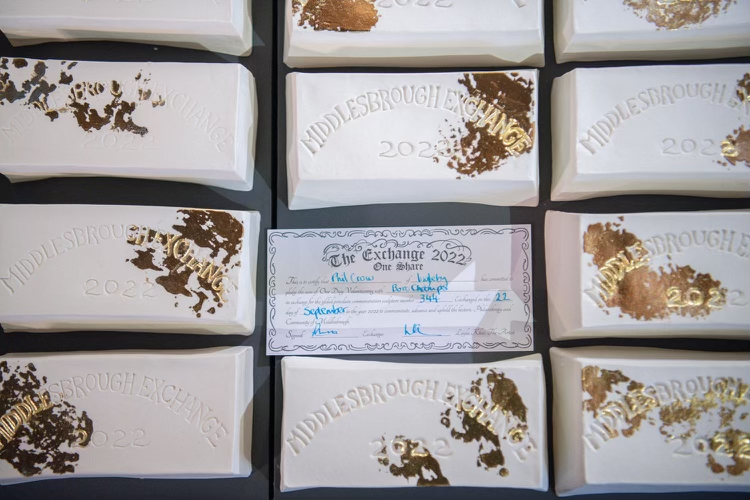

Upstairs, Layla Khoo’s ‘The Exchange’ (2022), the result of a residency between Tees Valley Arts and Middlesbrough Heritage Zone, offers a different take on the world order. Khoo has made 365 porcelain bricks stamped with gold leaf, one for each day of the year. Audiences are invited to take a limited-edition brick in exchange for a day of local voluntary work. Khoo’s work reminds us that while financial capital serves the few, other forms of social and communitarian capital (i.e. helping each other) remain in bountiful supply for the many.
Next door, Zetland, one many of the commandeered empty buildings, has a number of shows alongside an open call of artworks drawn from across the North East. Collectively, the exhibition attests to the vibrancy of the region’s art scene; artists grappling with topics as diverse as queerness, civic responsibility and the communicative inefficiency of language. In the same building is Objects at Play, an exhibition by Pippa Eason and Charlotte Dawson, two artists who share a sculptural affinity, with their playful interrogations of mass-produced domestic items. Across the show is a sense of formal and thematic rapport, riffing off interests and imbibing energies.
Over at Platform A in Middlesbrough train station, the group exhibition From Gesture to Geometry features a cast of female painters. Sarah Cooney’s modestly-scaled paintings are a standout. Her work hints at many things while remaining quietly insistent about the act of painting; we glimpse frames within frames, domestic spaces, elements of wallpaper and fabrics. Hot pink, veridian green and purple; her intensely patterned works recall Pierre Bonnard and put me in mind of contemporary painters such as Phoebe Unwin and Varda Caivano. Cooney reminds us that in a world of inattentiveness there can be power in modesty and intimacy.

From the intimate to the interactive, I head over to Hill Street shopping centre to see ‘ICU’ (2021), an AI work by music producer and coder A/B Smith. The work reads your face, parsing data to create an emotional map. In a world where smart speakers can detect illness in someone’s voice, tailoring advertising accordingly, Smith introduces us to the concealed processes that will soon dominate our environment. It seems we’re not quite there yet; the camera reads my face, telling me that I’m agitated, bored, joyful and remorseful. I’m obviously confusing the poor machine so head over to Navigator North’s pop-up exhibition. I bump into Saud Baloch who is in the act of making highly intricate ink drawings on paper. The surfaces of his drawings recall volcanic activity with incremental lines built up laboriously with fine pen, suggesting galaxies and moonscapes. The exhibition itself is immensely varied, ranging from collage and moving image work and painting, revealing some of the variety of creative production in Middlesbrough. Navigator’s Vicky Holbrough hands me a bag of biscuits and I take one before I head out for the last stop of the day.
I’m proud to call Tees Valley home, for a few years now. I’ve never lived anywhere like it (and I’ve lived and worked all over the place). I don’t normally, for instance, have gallery directors giving me biscuits when I walk around shows in London. Middlesbrough powered the world’s economy through its steel and iron and yet has often been powerless in the face of governmental neglect during moments of need. It has variously flourished with investment and survived during austerity. It is, then, a resonant location to think about the strategies and effects of power. In walking around MAW, I’m reminded of the power that can be created by a few people coming together in the spirit of community; something that is never in short supply in the Boro.
The Middlesbrough Art Weekender is co-founded and directed by Liam Slevin and Anna Byrne and curated by Kypros Kyprianou. The festival was recently awarded NPO status in a consortium bid with The Auxiliary Project Space in the latest round of ACE funding.
Middlesbrough Art Weekender ran from 22 to 25 September 2022.
George Vasey is a curator and writer.
This review is supported by The Auxiliary.
Featured content
Published 29.11.2022 by Aaron Juneau in Reviews
1,631 words

